|   |
March 14 - 17, 2018
Back in Calgary in May 2017, we were captivated when Helen and Gina made their pitch to attract Alliance people to celebrate its 40th anniversary in Tucson. Tucson, we were told, was the oldest continually settled community in the United States and was the traditional homeland of the Tohono O’odham and Pasqua Yaqui nations. A cultural crossroads, the region boasted Indigenous, Spanish Colonial, ranching, mining, military, territorial, Mexican, and mid-century modern heritage landscapes. But there was more!
It was, as they said, the only place in the United States to be designated a UNESCO World City of Gastronomy with its creative and cutting edge cuisine, steeped in the use of native foods and influenced by both Mexican and Native American cultures. And so we mentally marked our calendars and planned to gather in late winter 2018.
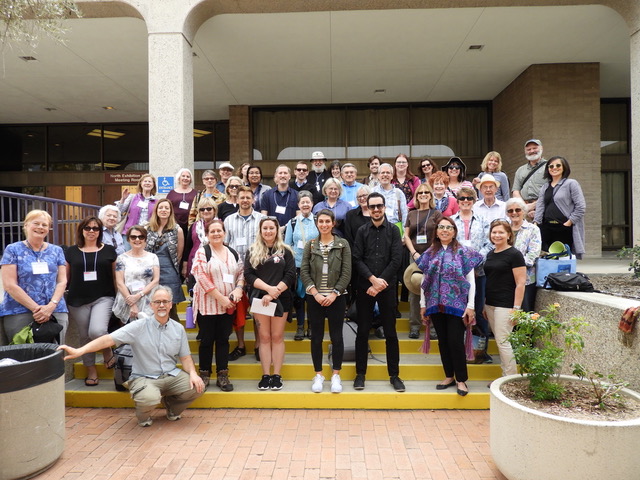
[Prior to that main event, a strategic planning exercise took place for the ‘future’ Alliance – led by that force of nature, Marilyn Opdyke – effectively two intense days of soul searching and visions (not to mention strategic objectives)! While much needs to be done, we are on the right track and are committed to strengthening the organization over the next five years.]
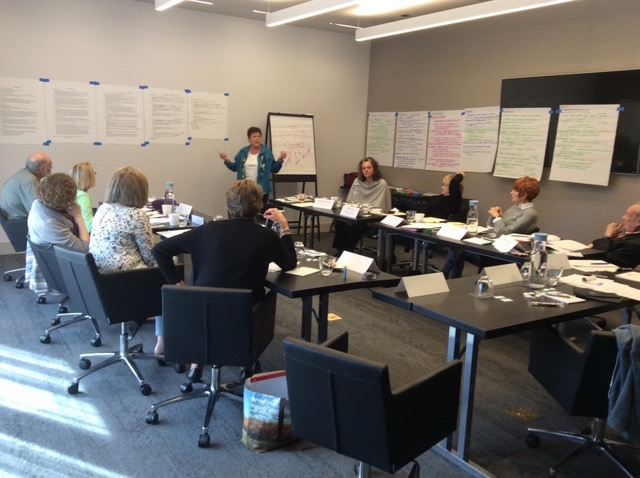
Strategic planning session
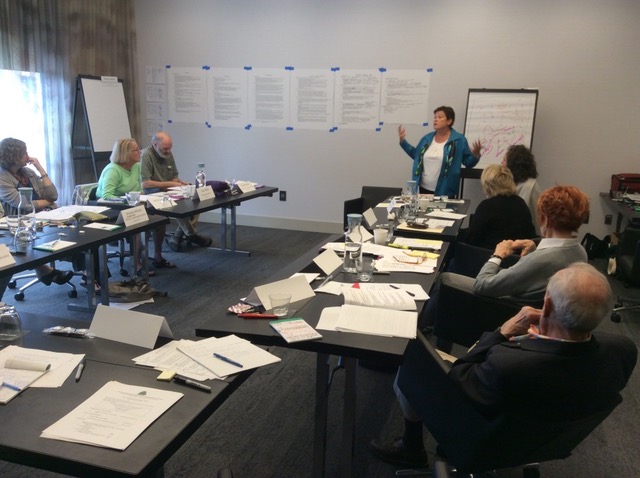
Marilyn Opdyke at the helm
The conference proper – Cultural Crossroads: Heritage Landscapes of the Sonoran Desert – commenced on the Wednesday evening with a welcome reception and our traditional round table poolside at the AC Tucson Marriott where we were holed up. People introduced themselves, shared their stories, and thus began the voyage of discovery for which the AHLP is renowned (at least according to the pre-strategic planning surveys that went out)!
Thursday morning saw Alex LaPierre of the Border Community Alliance kicking off the proceedings with a presentation about the history and context of Tucson. (It always helps to get one’s grounding in a new place.) A series of interesting presentations about places and people in and around the area followed, including the age-old question from El Rancho de las Golondrinas: “Where can we dig if we want zombies to come out of the ground?” (Thanks Jennifer!)
The morning ended with a special invitee from INAH, Raquel Padilla Ramos, who spoke on the topic of the Kino Mission Chain of Sonora and Arizona. We learned of the Tohono O’odham and Pasqua Yaqui peoples and their large territory (second largest in the country) which technically extends north into America and south into Mexico (border walls notwithstanding).
With packed lunches in hand, we then climbed onto a bus and were southbound to explore the Sonoran Desert and its rich cultural and natural history firsthand. Disembarking at Tumacacori National Historical Park we were able to experience the arid desert (although without the suffocating heat of the summer months, thankfully for those not accustomed to it!).
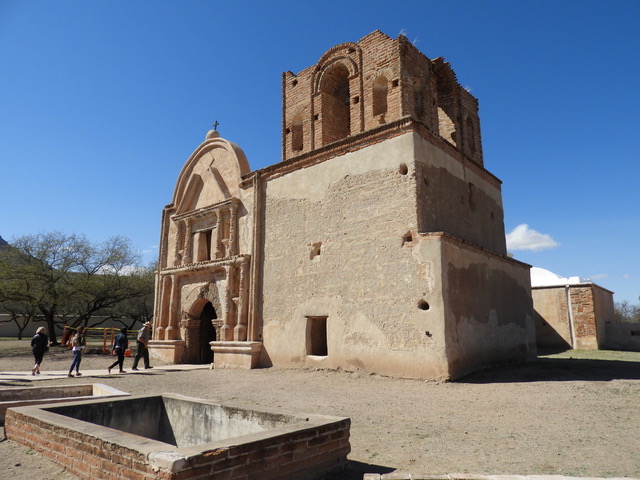
Tumacacori mission church

At the orchard
On arrival, we had a nice stroll in bright sunshine with docents telling us the story of Padre Eusebio Francisco Kino and his 17th century exploits. We heard about the irrigation system at Tumacacori, the resultant ‘essential’ orchard, and cemetery among other things. We were able to enter into the mission church proper where serious restorative work was underway (not ideal for a first time visitor but heartening for conservation people interested in protecting places that matter).
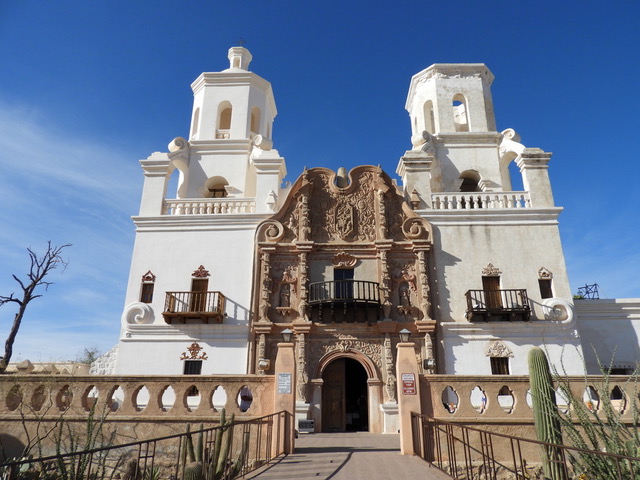
Mission San Xavier del Bac

The stunning interior
We were soon returning north to the amazing Mission San Xavier del Bac: originally established in the 1600s but with the current structure completed in the late 18th century. Again, fortuitously, we were able to hear from committed preservationists – Timothy Lewis and Matilde Rubio – who brought us up to speed on the lengthy program of protecting their/our collective heritage. A short visit up Grotto Hill to the east brought the visit to an end.
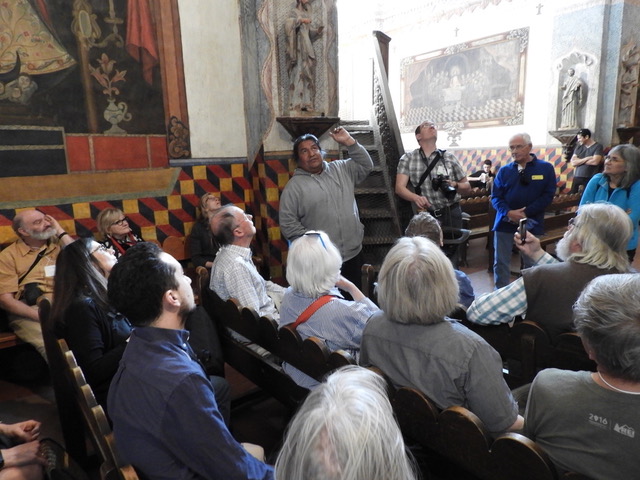
Timothy and Matilde sharing their work

A captivated audience

Atop Grotto Hill

View back from Grotto Hill
The late afternoon saw our arrival at Mission Garden: as the sun began its descent behind Chuk Shon and it began to cool off, waiting docents took the time to explain the various zones to us. Prior to boarding the bus for the return downtown, we had the opportunity to try locally produced wine.
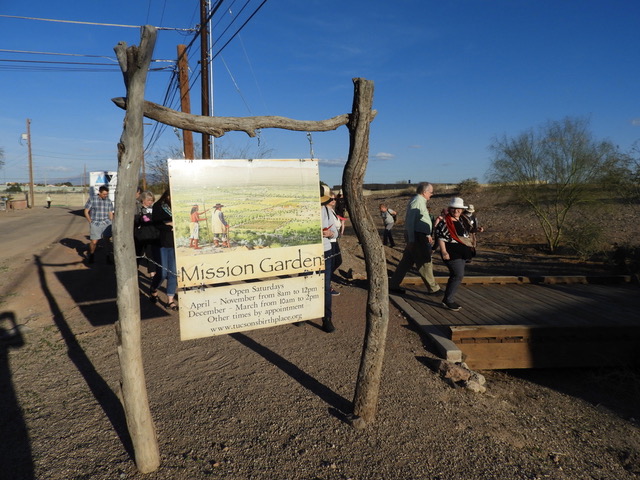
Mission Garden

One of the garden zones
The second morning was kicked off by Demion Clinco, who spoke on urban renewal and Modernism in our host city. And at morning’s end, after a number of terrific papers, Ian Milliken, concluded with an overview of the archaeological remains of Hohokam agriculture in the Tucson Basin (with the lovely story of age-old footprints, both human and canine).
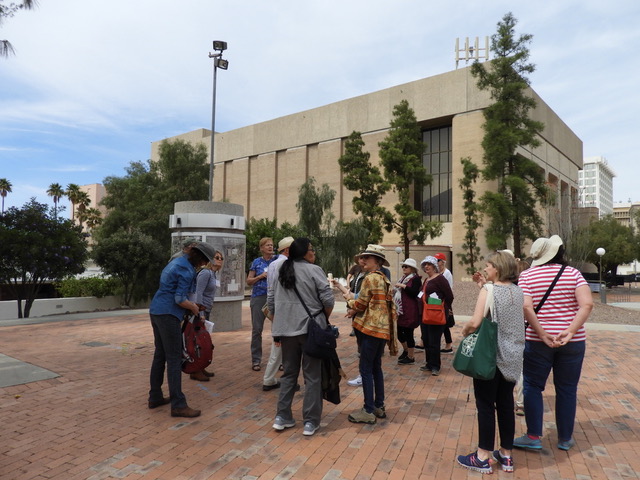
Helen and company at the TCC

One of the water-less pools
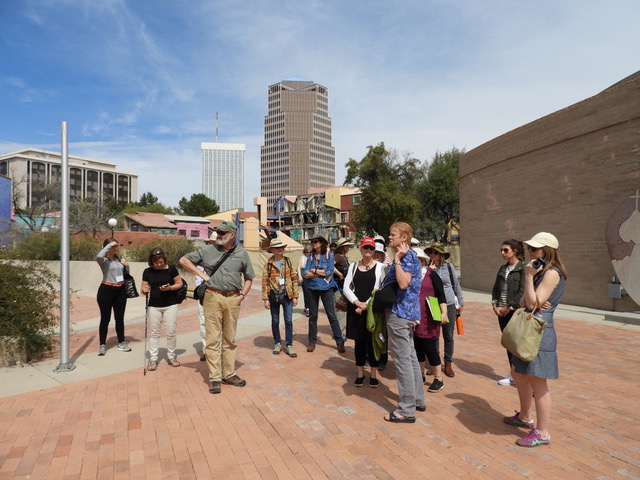
More of Eckbo’s work

En route to meet Ken and Brooks
Friday afternoon commenced with a brisk walk over to the Tucson Community Center, (TCC) notable for its execution in the 1970s and the efforts of Garrett Eckbo in designing its landscape. It is worth noting that Helen Erickson – one of our two tireless conference chairs – was instrumental in the TCC landscape being listed with the National Register in 2015. Further on, Ken Scoville and Brooks Jeffery contributed to a fulsome view of the place and its context: we now better understand its conception, development and on-going evolution.
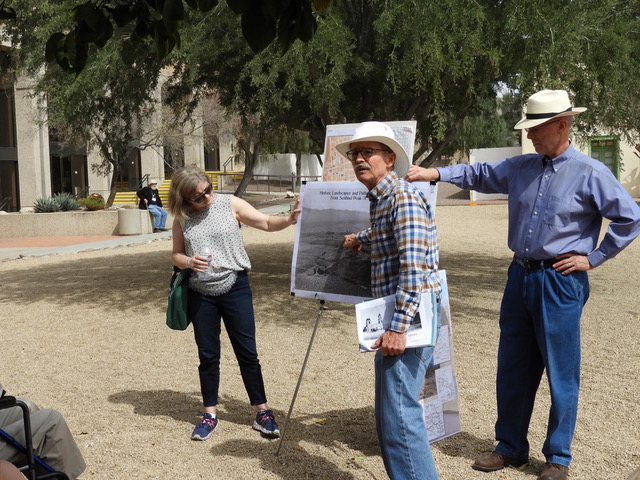
Ken and Brooks providing insight
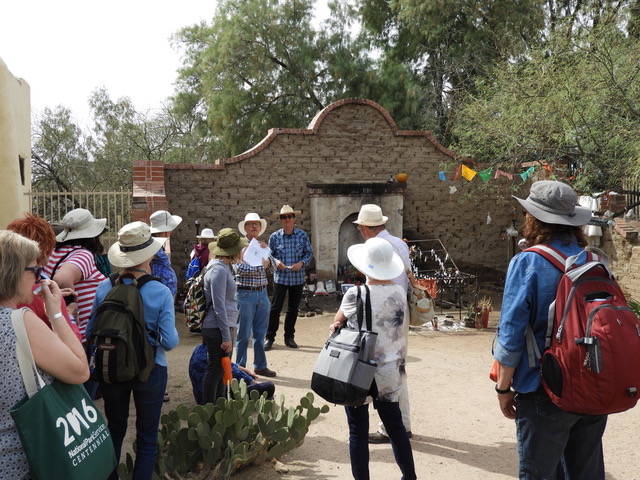
Ken and Bob at El Tiradito
On departing the TCC, the group proceeded southwards into the Barrio Viejo stopping first at the El Tiradito Shrine. Ken Scoville and Bob Vint described this Catholic shrine as a favourite place of writers, poets, and artists because it is dedicated to a sinner – who died fighting for the love of a woman – buried in unconsecrated ground. Visitors light candles for this man, hoping that his soul will be freed from purgatory.
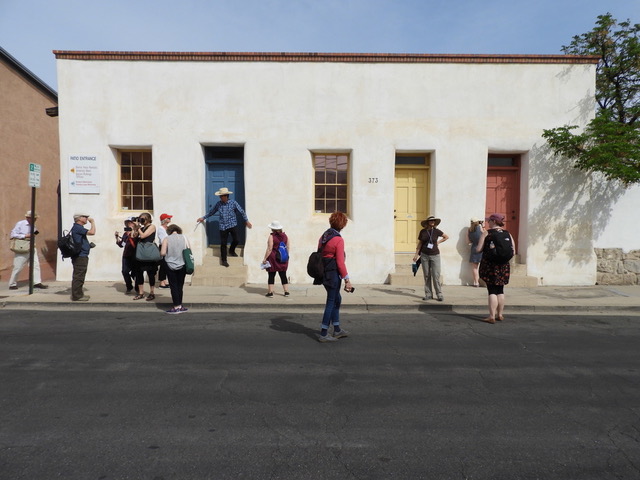
Traipsing through the barrio
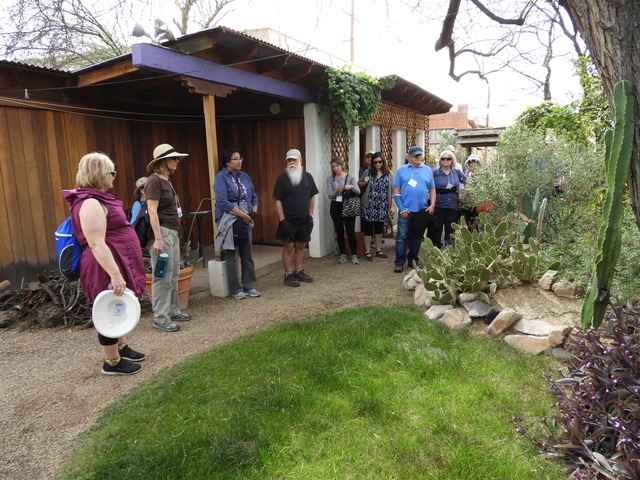
At Rocky Brittain’s place
Following a good meander through the barrio, and since we were nearby, we stopped at the home of Rocky Brittain, a former professor of architecture at UA. His efforts at creating a cozy courtyard home over two decades were clearly evident and would be appreciated even more in the heat of a Sonoran Desert summer.
On departing Rocky’s place, we turned a corner and, voila!, a fleet of vans awaited to ferry us up to Sentinel Peak Park (and the collegially marked ‘A’ Mountain) west of downtown. Once there we were greeted by Kendall and Verlon Jose of the Tohono O’odham Nation. After explaining to us the connection of their community to the landscape, they and their family members honoured us with two songs.

At Sentinel Peak Park

Kendall and Verlon Jose
The vans then ascended Tumamoc Hill – a significant site for the Tohono O’Odham – to witness even better views, not to mention the home of the Carnegie Desert Laboratory established in the early 20th century by Andrew Carnegie, a keen observer and admirer of the desert environment. This provided the first opportunity for first-time visitors to get up close (but not too personal) with Saguaro cacti.
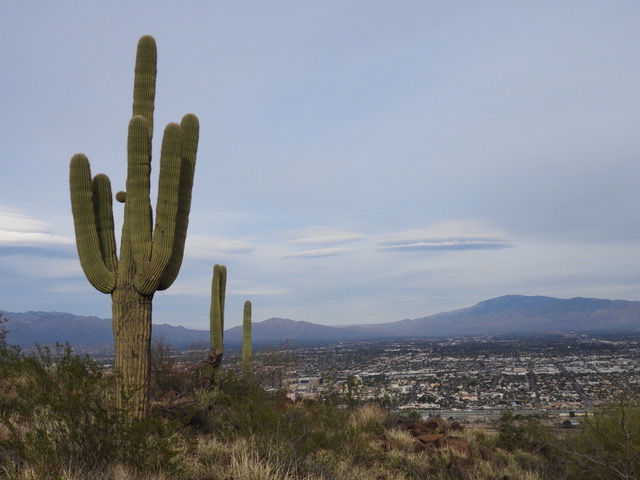
Atop Tumamoc Hill
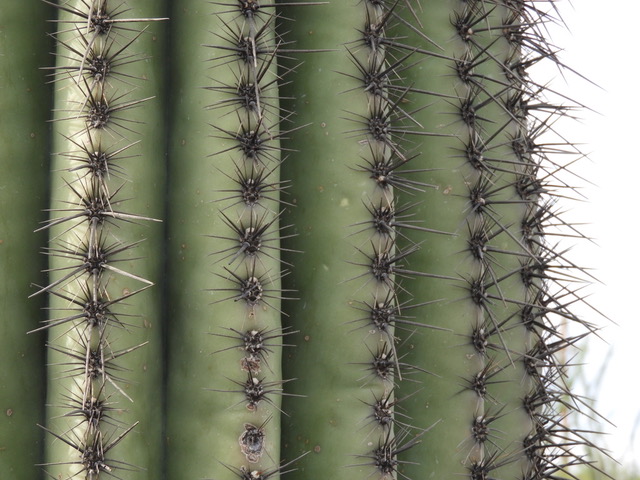
A saguaro cactus up close
On our descent from the mountain, a quick supper break then led to ‘antique’ buses courtesy of the Old Pueblo Trolley for a nighttime tour of multiple restored neon signs. Our guides, Jude Cook, Carlos Lozano and Kathe Kubish provided an informative commentary for our Tucson Friday night tour, a decided conference highlight!
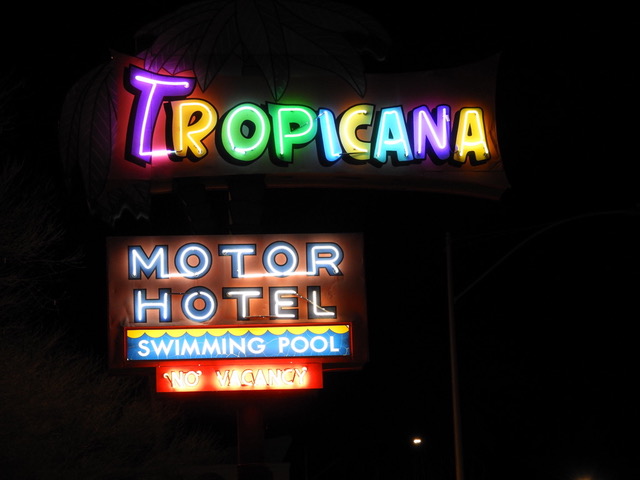
The Tropicana

Susan in the glow
The last morning on the last day of any AHLP conference is typically characterized by noticeable – if understandable – flagging energy levels. In spite of this, AHLP President Brenda Williams gave an energizing promo for Detroit in 2019. And, as an homage to Susan Buggey and her three AHLP co-conspirators in 1978, John Zvonar offered a whirlwind historical tour of an organization celebrating its 40th anniversary.
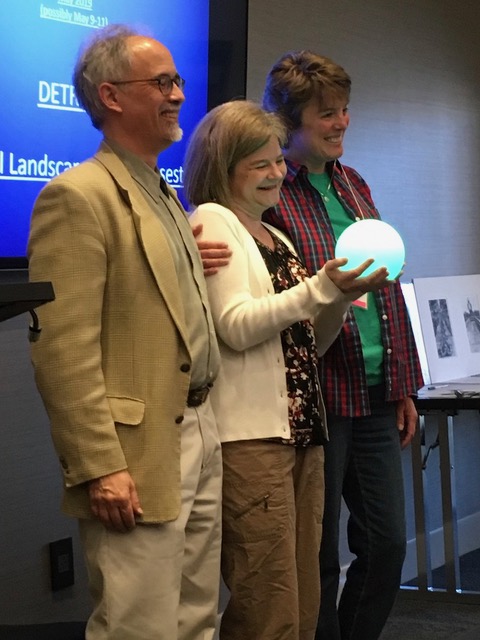
The orb in good hands
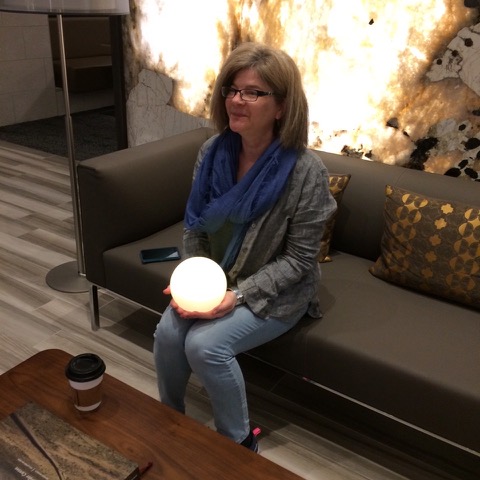
En route to Wisconsin
This moment also provided an opportunity for Brenda to offer a quick overview of the strategic planning exercise from earlier in the week. Brenda spoke in part about what she felt was the ‘essence’ of the organization, using the metaphor of an ‘orb’ and our collective responsibility to protect and to nurture it. Serendipity being what it is, at this point Carrie Gregory bounded to the front of the room with the gift of a real ‘orb’ for Brenda, to the surprise and delight of all present. All will be happy to know that it, and she, are now safely ensconced in Madison, Wisconsin.

Arrival at the camp
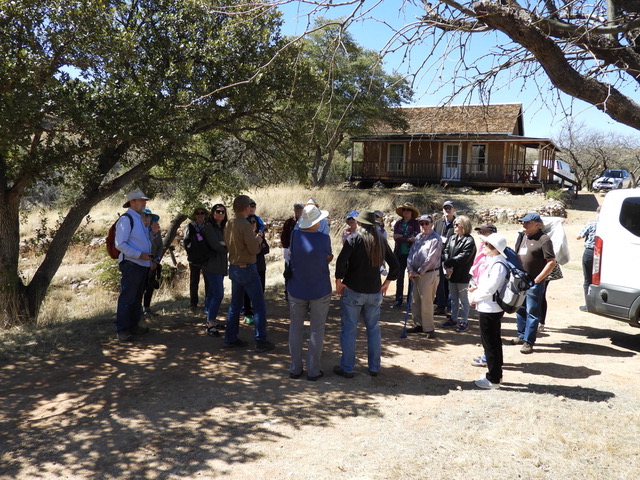
An introduction to the story
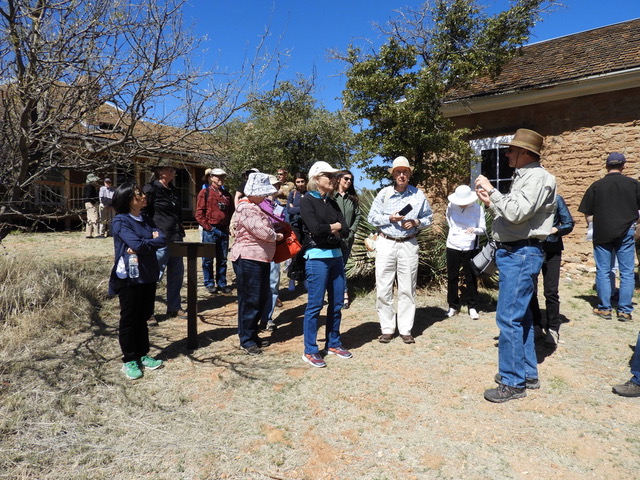
Mark Doumas answering questions

A nozzle used for mining gold
Invited guest speaker Robin Lothrop Pinto then offered an overview of ranching in Southeastern Arizona to get us ready for the afternoon road tour. On release from the hotel, the cavalcade of vans then headed out on the I-10 southeastwards to Kentucky Camp (and the story of hydraulic gold mining and the necessity of water told by Mark Doumas). Then we were off to the Empire Ranch, the fabulous story of four stakeholders since 1867 and on-going restoration work. Thanks to Scott Thompson, Eric Means and Robin Pinto for their insights.
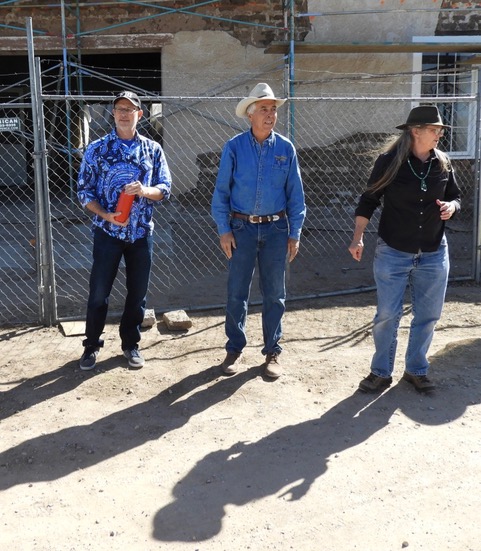
Scott, Eric and Robin

Exploring the ranch
Returning to Tucson, we arrived at La Cocina for some youthful mariachi enthusiastically performed by Los Changuitos Feos, or ‘the ugly little monkeys’. We shared drinks and snacks in advance of the finale banquet down the street at Café a la C’Art. Good food and libations, kind words of praise all around and an energetic completion to the silent auction brought the proceedings to a close.

A passionate rendering

A serenade
Alas, all good things must come to an end, and so it was with AHLP 2018 (at least for the majority of attendees who were not bound the next day for the border and Mexico)! The Alliance is very pleased to acknowledge the two student scholarship winners for 2018, Jameson Reeves and Yung-Ju Kim. We hope to see them back at some point in the (near?) future.
Through the course of our stay, the weather was superb and the hotel served us well, right from the strategic planning session to the Board meeting to those conference mornings. And it was very convenient to breakfast burritos at Johnny Gibson’s nearby. All in all a handy spot!
But our hostesses! Thanks to helpers Jaimie Luria and Katheryn McKinney for keeping us on track, but especially to our conference co-chairs Gina Chorover and Helen Erickson for their keen foresight and unparalleled planning/execution. They have unwittingly added yet another great gathering to a pantheon of great gatherings of the Alliance! Muchas gracias eh?!
From the desk of Marilyn Muleski
Departing very early on the Sunday morning, two dozen Alliance members – led by the indefatigable Gina – headed off in two vans on a post-conference tour to the state of Sonora, Mexico. The primary purpose of the tour was to visit two additional Father Kino missions.
Our first stop was at a Burger King on the U.S. side of the city of Nogales, where we met our guide, Alex LaPierre, from the Border Community Alliance. The BCA’s mission is “fostering community through education, collaboration and cultural exchange.” (Alex had been an invited speaker at our conference, providing a history of Tucson and its development.) From the Burger King (an easily recognized landmark with parking!), the group walked across the border – and the giant wall there – and set off with our Mexican drivers and guides in two vans.
Our first stop was a service centre in Imur where local men sold travellers a variety of foods prepared at home. Their quesadillas were great! After our tasty snacks we continued on to the town of San Ignacio, site of an early mission founded by Father Kino that is located on one side of the town square and still in use. We also visited a town resident to learn how she made quince paste.

San Ignacio (Gertz, 2018)
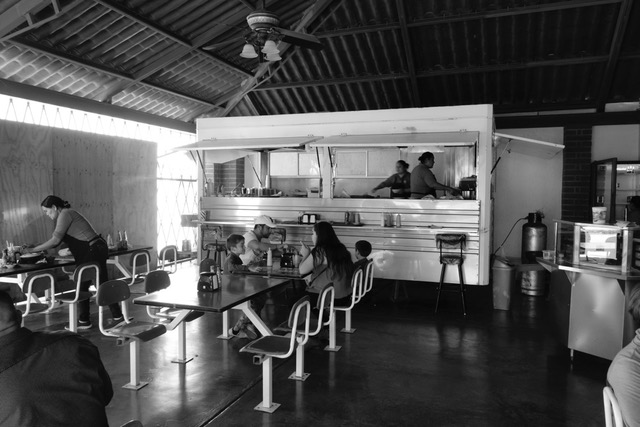
Seafood restaurant in Magdalena (McLachlan, 2018)
We then proceeded to the delightful town of Magdalena de Kino, which was selected as a Pueblo Mágico (Magic Town) by the Mexican federal government for its scenic and historical qualities. We started at Plaza Monumental and its temple, which houses the crypt of Father Kino. A mural on the ceiling over the tomb tells stories of Kino’s work. We also paid quick visits to Santa Maria Magdalena Mission and the nearby Capilla de San Francisco.

Tomb of Father Keno in Magdalena (McLachlan, 2018)
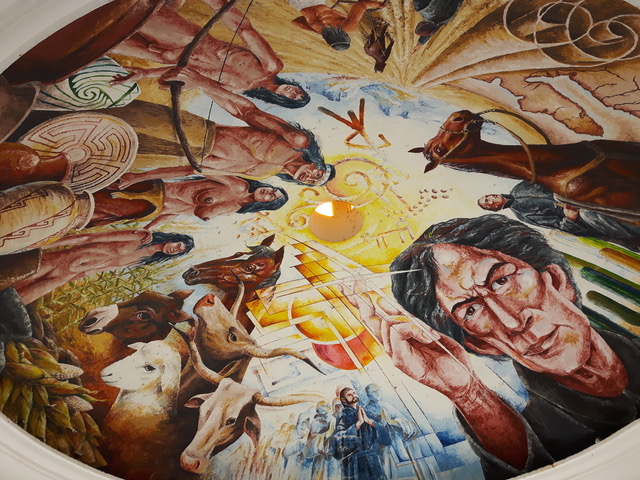
The ceiling mural (Muleski, 2018)
Alex led us on a walking tour through the market area just off the plaza on our way to lunch at a small family-operated seafood restaurant. It was Alex’s birthday – a cake magically appeared – and he was serenaded in both Spanish and English.

City hall (Gertz, 2018)
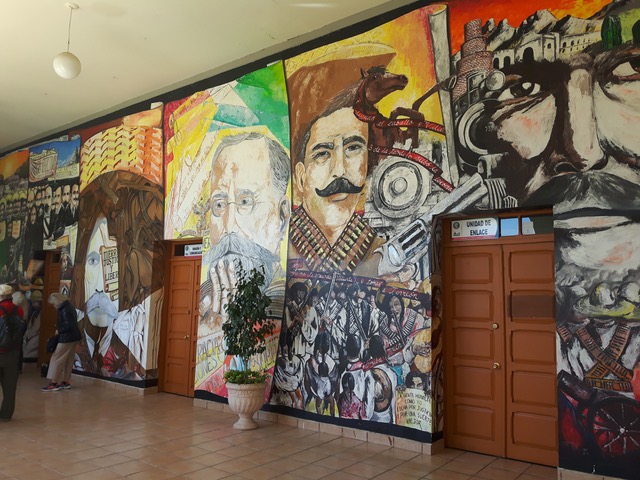
Mural at city hall (Muleski, 2018)
After lunch and birthday cake, we continued to the Palacio Municipal (City Hall), a magnificent structure that mixes colonial and modern influences. Inside are colourful murals portraying the history of the city. From there it was back in the vans for the trip to Nogales, Mexico, a walk across the border back to the U.S., and the final leg of our journey back to Tucson.
The tour was a magnificent opportunity to extend our conference experience for an additional day, to learn about the cultural and historic links that transcend the border in this part of the continent, and to enjoy good food, good scenery and good company.
Our Special Invited Guests
Alex La Pierre is the program director for the Border Community Alliance – formerly with NPS at Tumacacori, current student of Arizona history at UA.
Raquel Padilla Ramos works for the INAH (Mexican Park Service). Her special areas are the Yaqui and the Kino Missions in Mexico.
Demion Clinco is the CEO of the Tucson Historic Preservation Foundation, which presents Modernism Week in Tucson on an annual basis.
Ian Milliken is an archaeologist who works for Pima County. One of his projects included the recent discovery of human (and canine) footprints in conjunction with irrigated agricultural plots along the Santa Cruz River west of Tucson.
Robin Lothrop Pinto is a historic landscape architect who specializes in historic ranches. She has done work at Faraway Ranch, the ranches of Organ Pipe Cactus National Monument, Canoa, and, of course, Empire Ranch.